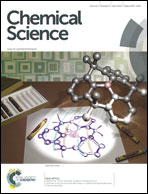A series of C3-symmetric heterobimetallic Cr–M (M = Fe, Co and Cu) complexes†
Abstract
A series of tris(phosphinoamide) heterobimetallic Cr–M (M = Fe, Co and Cu) complexes has been investigated in an effort to probe and contribute to the understanding of the electronic structure and metal–metal bonding in heterobimetallic complexes of the first row transition metals. The chromium tris(phosphinoamide), [Cr(iPrNPPh2)3] (1), is a useful isolable precursor and can be treated with MI2 under reducing conditions to form [Cr(iPrNPPh2)3M–I] (M = Fe (2), Co (3)). Both of these complexes can be reduced by one electron to generate [Cr(iPrNPPh2)3M–PMe3] (M = Fe (4), Co (5)). The Cr–Cu complex [Cr(iPrNPPh2)3Cu–I] (6) has also been synthesized for comparison. The solid state structures of 2–6 have been determined crystallographically, revealing relatively short metal–metal interatomic distances. Mössbauer spectroscopy, cyclic voltammetry, and computational methods have been used to evaluate the electronic structure and metal–metal interactions in these unique bimetallic complexes in an effort to uncover the underlying factors that affect metal–metal bonding between elements of the first row transition series.


 Please wait while we load your content...
Please wait while we load your content...